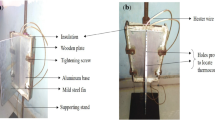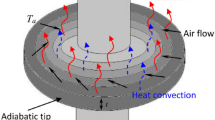Abstract
The major objectives in the design of thermal systems are obtaining the information about thermophysical, transport and boundary properties. The main purpose of this paper is to estimate the unknown heat flux at the surface of a solid body. A constant area mild steel fin is considered and the base is subjected to constant heat flux. During heating, natural convection heat transfer occurs from the fin to ambient. The direct solution, which is the forward problem, is developed as a conjugate heat transfer problem from the fin and the steady state temperature distribution is recorded for any assumed heat flux. In order to model the natural convection heat transfer from the fin, an extended domain is created near the fin geometry and air is specified as a fluid medium and Navier Stokes equation is solved by incorporating the Boussinesq approximation. The computational time involved in executing the forward model is then reduced by developing a neural network (NN) between heat flux values and temperatures based on back propagation algorithm. The conjugate heat transfer NN model is now coupled with Genetic algorithm (GA) for the solution of the inverse problem. Initially, GA is applied to the pure surrogate data, the results are then used as input to the Levenberg- Marquardt method and such hybridization is proven to result in accurate estimation of the unknown heat flux. The hybrid method is then applied for the experimental temperature to estimate the unknown heat flux. A satisfactory agreement between the estimated and actual heat flux is achieved by incorporating the hybrid method.


















Similar content being viewed by others
References
Adili A, Hasni N, Kerkeni C, Nasrallah SB (2010) An inverse problem based on genetic algorithm to estimate thermophysical properties of fouling. Int J Therm Sci 49(6):889–900
Ahamad SI, Balaji C (2015) A simple thermal model for mixed convection from protruding heat sources. Heat Transfer Eng 36(4):396–407
Ahamad SI, Balaji C (2016) Inverse conjugate mixed convection in a vertical substrate with protruding heat sources: a combined experimental and numerical study. Heat Mass Transf 52(6):1243–1254
Beck JV (1970) Nonlinear estimation applied to the nonlinear inverse heat conduction problem. Int J Heat Mass Transfer 13(4):703–716
Beck JV, Blackwell B, Clair CRS Jr (1985) Inverse heat conduction: Ill-posed problems. Wiley-Interscience publications
Colaço MJ, Orlande HR (2004) Inverse natural convection problem of simultaneous estimation of two boundary heat fluxes in irregular cavities. Int J Heat Mass Transf 47(6):1201–1215
Colaço MJ, Orlande HR, Dulikravich GS (2006) Inverse and optimization problems in heat transfer. J Braz Soc Mech Sci Eng 28(1):1–24
Cui M, Yang K, Xu XL, Wang SD, Gao XW (2016) A modified levenberg–marquardt algorithm for simultaneous estimation of multi-parameters of boundary heat flux by solving transient nonlinear inverse heat conduction problems. Int J Heat Mass Transfer 97:908–916
Deng H, Guessasma S, Montavon G, Liao H, Coddet C, Benkrid D, Abouddi S (2005) Combination of inverse and neural network methods to estimate heat flux. Numerical Heat Transfer Part A: Applications 47(6):593–607
Deng S, Hwang Y (2006) Applying neural networks to the solution of forward and inverse heat conduction problems. Int J Heat Mass Transfer 49(25):4732–4750
Dorfman AS (2009) Conjugate problems in convective heat transfer. CRC Press, Boca Raton
Fluent A (2012) 14.5, Theory guide. ansys. Inc., Canonsburg
Gnanasekaran N, Kumar S, Kumar H (2016) A neural network based method for estimation of heat generation from a teflon cylinder. Frontiers in Heat and Mass Transfer (FHMT) 7(1):1–7
Goldberg DE (2006) Genetic algorithms. Pearson Education, India
Gosselin L, Tye-Gingras M, Mathieu-Potvin F (2009) Review of utilization of genetic algorithms in heat transfer problems. Int J Heat Mass Transfer 52(9):2169–2188
Huang C, Özisik M (1992) Inverse problem of determining unknown wall heat flux in laminar flow through a parallel plate duct. Numer Heat Transfer 21(1):55–70
Huang CH, Wang SP (1999) A three-dimensional inverse heat conduction problem in estimating surface heat flux by conjugate gradient method. Int J Heat Mass Transfer 42(18):3387–3403
Imani A, Ranjbar A, Esmkhani M (2006) Simultaneous estimation of temperature-dependent thermal conductivity and heat capacity based on modified genetic algorithm. Inverse Prob Sci Eng 14(7):767–783
Kim HJ, Kim NK, Kwak JS (2006) Heat flux distribution model by sequential algorithm of inverse heat transfer for determining workpiece temperature in creep feed grinding. Int J Mach Tools Manuf 46(15):2086–2093
Krejsa J, Woodbury K, Ratliff J, Raudensky M (1999) Assessment of strategies and potential for neural networks in the inverse heat conduction problem. Inverse Prob Eng 7(3):197–213
Liu FB (2008) A modified genetic algorithm for solving the inverse heat transfer problem of estimating plan heat source. Int J Heat Mass Transfer 51(15):3745–3752
Machado H, Orlande HR (1997) Inverse analysis for estimating the timewise and spacewise variation of the wall heat flux in a parallel plate channel. Int J Numer Methods Heat Fluid Flow 7(7):696–710
Monde M, Arima H, Mitsutake Y (2003) Estimation of surface temperature and heat flux using inverse solution for one-dimensional heat conduction. J Heat Transf 125(2):213–223
Orlande HR (2012) Inverse problems in heat transfer: new trends on solution methodologies and applications. Journal of Heat Transfer 134(3):031,011
Ozisik MN, Orlande HRB (2000) Inverse heat transfer: fundamentals and applications. CRC Press, Boca Raton
Park H, Chung O (1999) An inverse natural convection problem of estimating the strength of a heat source. Int J Heat Mass Transfer 42(23):4259–4273
Park H, Chung O (2000) On the solution of an inverse natural convection problem using various conjugate gradient methods. Int J Numer Methods Eng 47(4):821–842
Peng H, Ling X (2008) Optimal design approach for the plate-fin heat exchangers using neural networks cooperated with genetic algorithms. Appl Therm Eng 28(5):642–650
Premachandran B, Balaji C (2011) Conjugate mixed convection with surface radiation from a vertical channel with protruding heat sources. Numerical Heat Transfer Part A: Applications 60(2):171–196
Raudenskỳ M, Horskỳ J, Krejsa J (1995) Usage of neural network for coupled parameter and function specification inverse heat conduction problem. Int Commun Heat Mass Transfer 22(5):661–670
Raudenskỳ M, Woodbury KA, Kral J, Brezina T (1995) Genetic algorithm in solution of inverse heat conduction problems. Numerical Heat Transfer Part B Fundamentals 28(3):293– 306
Reddy BK, Balaji C (2015) Bayesian estimation of heat flux and thermal diffusivity using liquid crystal thermography. Int J Therm Sci 87:31–48
Sablani S, Kacimov A, Perret J, Mujumdar A, Campo A (2005) Non-iterative estimation of heat transfer coefficients using artificial neural network models. Int J Heat Mass Transfer 48(3):665–679
Sanaye S, Hajabdollahi H (2010) Thermal-economic multi-objective optimization of plate fin heat exchanger using genetic algorithm. Appl Energy 87(6):1893–1902
Saniei E, Setayeshi S, Akbari ME, Navid M (2016) Parameters estimation of breast tumour using dynamic neural network from thermal pattern. J Adv Res
Shiguemori ÉH, Da Silva JDS, de Campos Velho HF (2004) Estimation of initial condition in heat conduction by neural network. Inverse Prob Sci Eng 12(3):317–328
Sreekanth S, Ramaswamy H, Sablani S, Prasher S (1999) A neural network approach for evaluation of surface heat transfer coefficient. J Food Process Preserv 23(4):329–348
Taler J (2007) Determination of local heat transfer coefficient from the solution of the inverse heat conduction problem. Forsch Ingenieurwes 71(2):69–78
Ukrainczyk N (2009) Thermal diffusivity estimation using numerical inverse solution for 1d heat conduction. Int J Heat Mass Transfer 52(25):5675–5681
Venugopal G, Balaji C, Venkateshan S et al (2009) A hybrid optimization technique for developing heat transfer correlations based on transient experiments. Int J Heat Mass Transfer 52(7):1954–1964
Verma S, Balaji C (2007) Multi-parameter estimation in combined conduction–radiation from a plane parallel participating medium using genetic algorithms. Int J Heat Mass Transfer 50(9):1706–1714
Woodbury KA (1990) Effect of thermocouple sensor dynamics on surface heat flux predictions obtained via inverse heat transfer analysis. Int J Heat Mass Transfer 33(12):2641– 2649
Zhang L, Li L, Ju H, Zhu B (2010) Inverse identification of interfacial heat transfer coefficient between the casting and metal mold using neural network. Energy Convers Manag 51(10):1898–1904
Acknowledgments
The authors would like to thank Prof. K.V. Gangadharan, SOLVE-RT Lab (funded by NMEICT, MHRD, Govt. of India) NITK Surathkal for providing us instrumentation to carry out experiments. The authors would also like to thank Dr. Mahesh Anand, Founder & CTO, Scientific Computing Solutions, Chennai for useful interaction regarding evolutionary algorithms.
Author information
Authors and Affiliations
Corresponding author
Ethics declarations
Conflict of interests
On behalf of all authors, the corresponding author states that there is no conflict of interest.
Additional information
Publisher’s Note
Springer Nature remains neutral with regard to jurisdictional claims in published maps and institutional affiliations.
Rights and permissions
About this article
Cite this article
M K, H.K., P S, V., N, G. et al. A combined ANN-GA and experimental based technique for the estimation of the unknown heat flux for a conjugate heat transfer problem. Heat Mass Transfer 54, 3185–3197 (2018). https://doi.org/10.1007/s00231-018-2341-3
Received:
Accepted:
Published:
Issue Date:
DOI: https://doi.org/10.1007/s00231-018-2341-3




